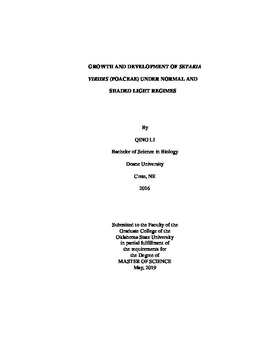| dc.contributor.advisor | Doust, Andrew | |
| dc.contributor.author | Li, Qing | |
| dc.date.accessioned | 2019-10-25T20:25:29Z | |
| dc.date.available | 2019-10-25T20:25:29Z | |
| dc.date.issued | 2019-05-01 | |
| dc.identifier.uri | https://hdl.handle.net/11244/321629 | |
| dc.description.abstract | Plants rely on photosynthesis to gain energy for growth, yet most plants are found with other plants, and therefore need to deal with varying degrees of shading. Shading by plants affects both the spectrum (especially red (R) to far-red (FR) ratio) and the amount of photosynthetically active radiation (PAR, 400-700 nm). The effect of shade (shade tolerance/ shade avoidance syndrome) has been well studied in the dicot species Arabidopsis thaliana, but relatively little in grasses. In addition, few studies have investigated the developmental trajectory of plants under different shading treatments. The goal of this study is to understand the effect of light quality and quantity on shade responses in the C4 grass, Setaria viridis. To achieve this, plants were grown under combinations of high or low light intensity, paired with high or low R:FR (mimicking sunlight or shade respectively) in continuous light. Both top view and side view images were taken at 15 min intervals during the growth of the plants, with a custom-designed imaging system that used individual Raspberry Pi NOIR cameras dedicated to each plant. Custom OpenCV scripts were written to extract relevant plant trait information from the images, including blade vertex coordinates and height. Our novel approach allows us to capture the behavior of individual organs, rather than more commonly used measures that focus on overall plant shape. By flowering time, plant shading (both simulated by the reduction of R:FR and by reduced light intensity) resulted in a significant increase of height, number of tillers, and biomass of plants. Analysis during growth and development also revealed changes in leaf orientation and increased variation in leaf position and leaf movement in plants grown under low R:FR. We found that the third leaf length and leaf growth rate was primarily influenced by light intensity, but that most other traits were influenced by either light quality or the interaction between quality and intensity. | |
| dc.format | application/pdf | |
| dc.language | en_US | |
| dc.rights | Copyright is held by the author who has granted the Oklahoma State University Library the non-exclusive right to share this material in its institutional repository. Contact Digital Library Services at lib-dls@okstate.edu or 405-744-9161 for the permission policy on the use, reproduction or distribution of this material. | |
| dc.title | Growth and Development of Setaria viridis (Poaceae) Under Normal and Shaded Light Regimes | |
| dc.contributor.committeeMember | Yang, Ming | |
| dc.contributor.committeeMember | Kakani, Gopal | |
| dc.contributor.committeeMember | Wood, Chris | |
| osu.filename | Li_okstate_0664M_16228.pdf | |
| osu.accesstype | Open Access | |
| dc.type.genre | Thesis | |
| dc.type.material | Text | |
| dc.subject.keywords | development | |
| dc.subject.keywords | growth | |
| dc.subject.keywords | r:fr | |
| dc.subject.keywords | setaria viridis | |
| dc.subject.keywords | shading | |
| thesis.degree.discipline | Plant Biology | |
| thesis.degree.grantor | Oklahoma State University | |
